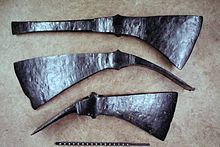Dolabra


A dolabra (plural: dolabrae) is an ancient tool that was used in particular for entrenchment work in the Roman army and is therefore also referred to as a "pioneer ax". It had two cutting edges on one shaft, one vertical and one horizontal. The Dolabra can therefore be described as a combination of ax and hoe , similar to the hoopoe hoe that is still used today . Accordingly, the Dolabra was used both for woodworking (corresponding to the later hoe ) as well as for earthwork and for tearing down walls. The shape of the double-edged ax is still used today as a fire fighting ax .
Dolabrae are mentioned several times in ancient literature, are depicted on the reliefs of the Trajan column and are found in the finds from imperial military camps , such as the Roman camp in Hedemünden . They are also part of battlefield finds such as in Kalkriese and the Harzhorn event .
- Ax and hoe
literature
- Fritz-Rudolf Herrmann : The iron hoard find from the Künzing fort. In: Saalburg yearbook. Volume 26, 1969, pp. 129-141.
- Rainer Wiegels , Günther Moosbauer , Michael Meyer , Petra Lönne , Michael Geschwinde : A Roman Dolabra with an inscription from the area around the battlefield on the Harzhorn (district of Northeim) in Lower Saxony . In: Archaeological correspondence sheet . Volume 41, 2011, pp. 561-570.

